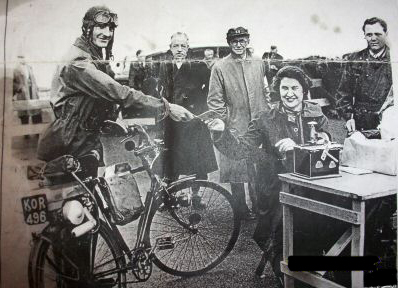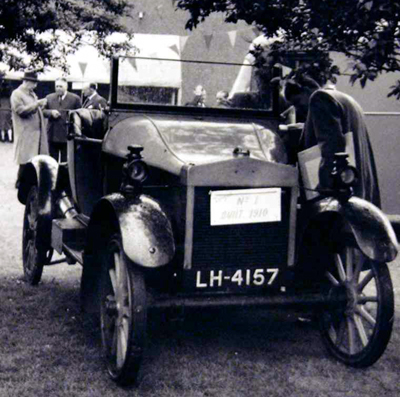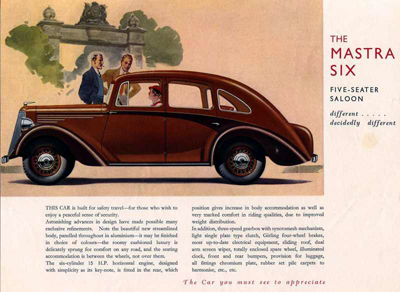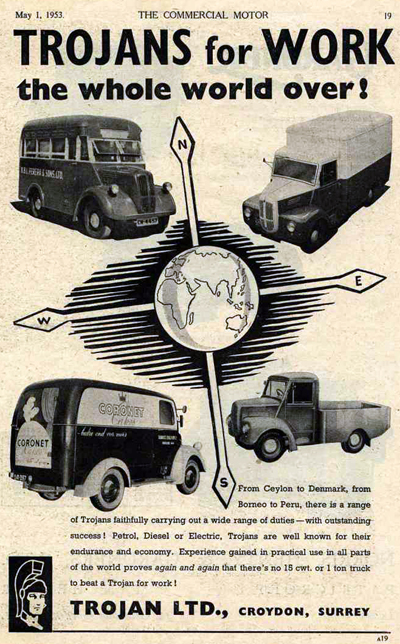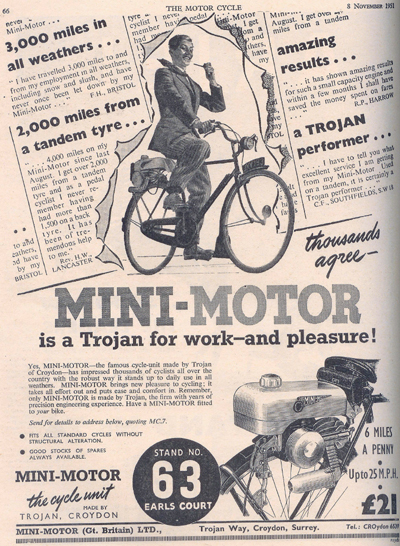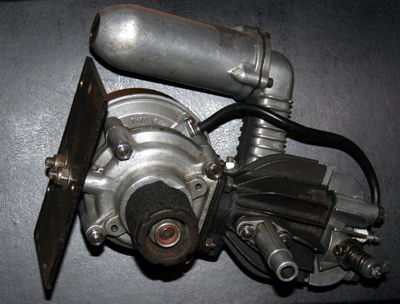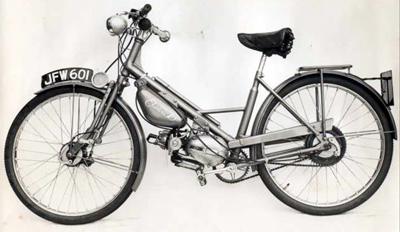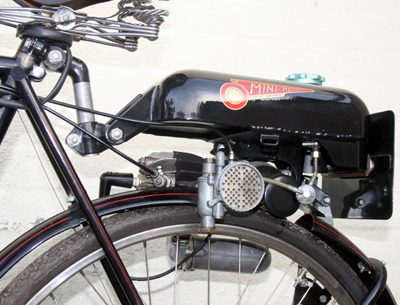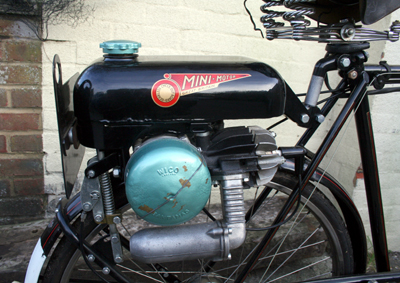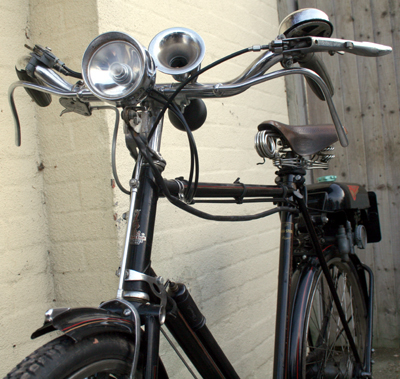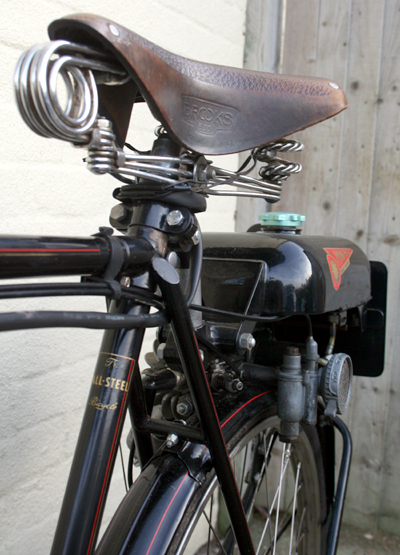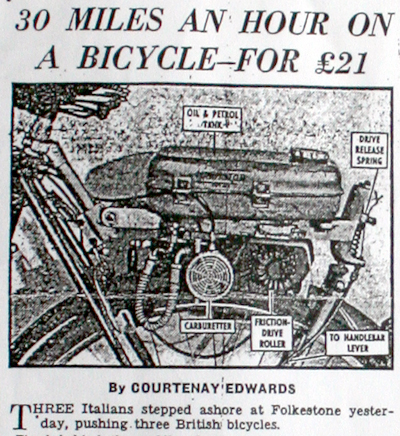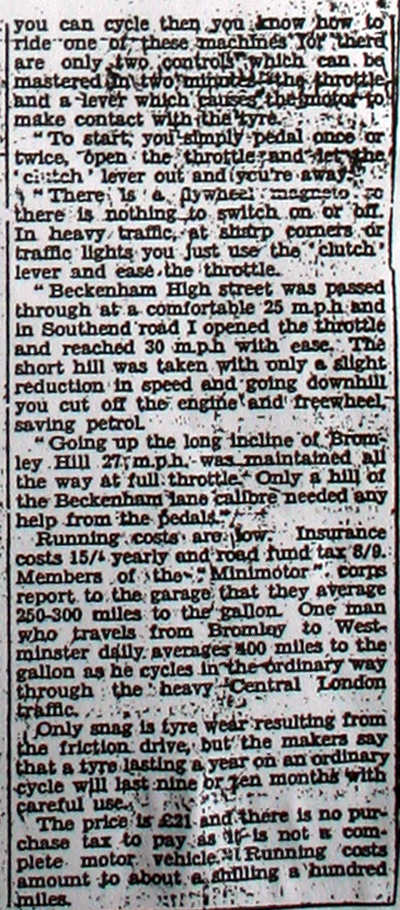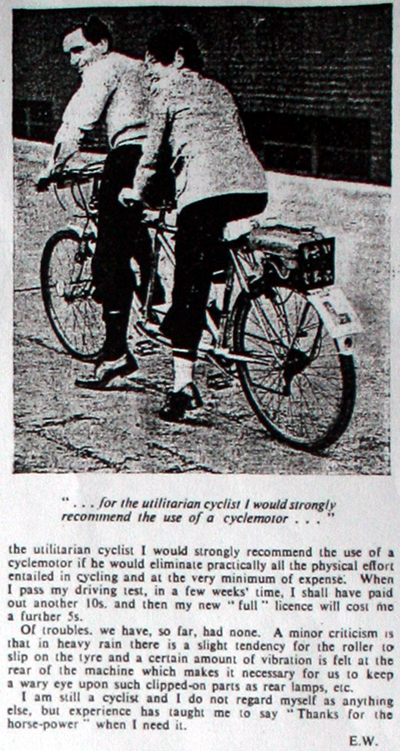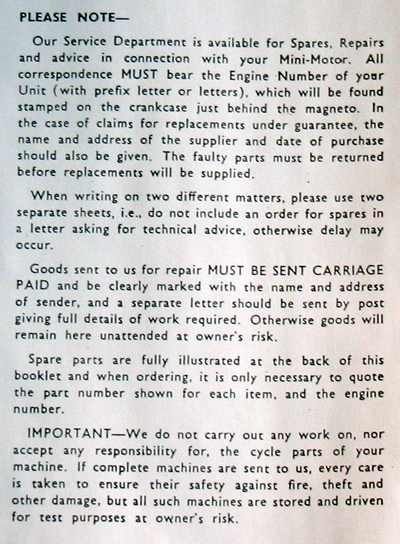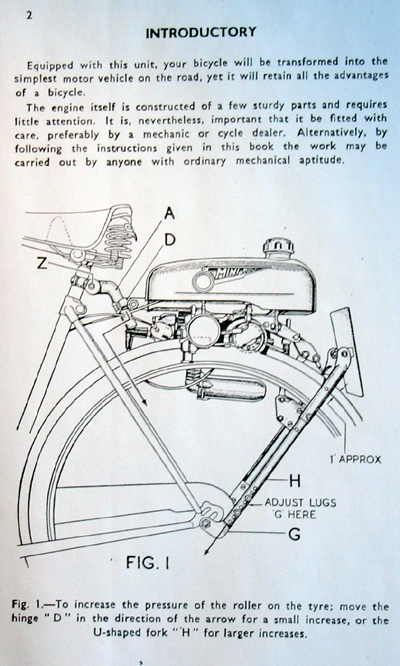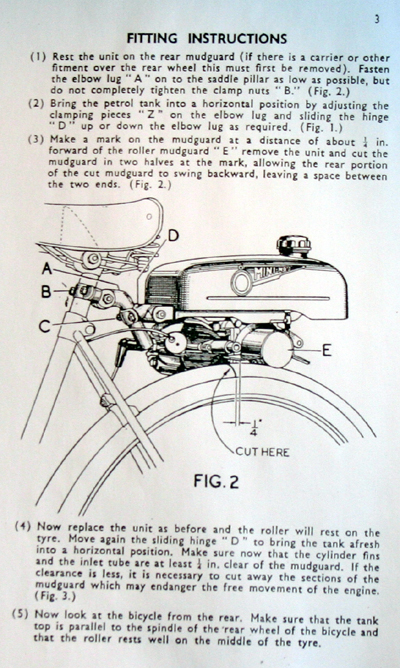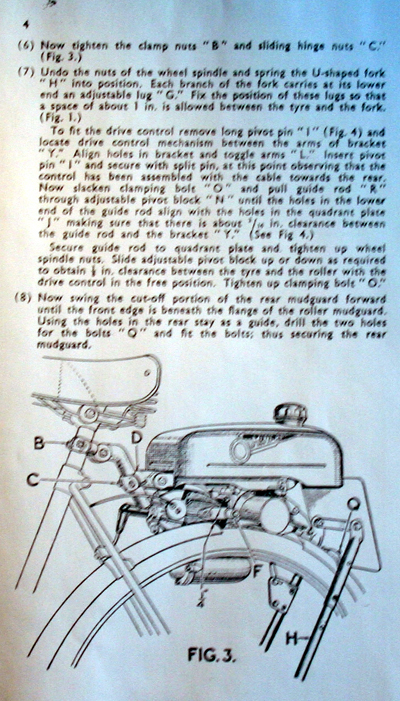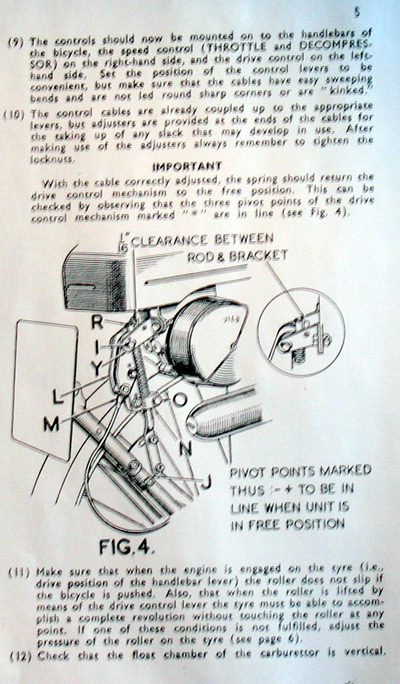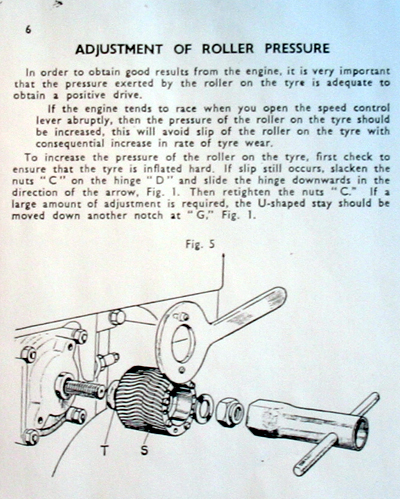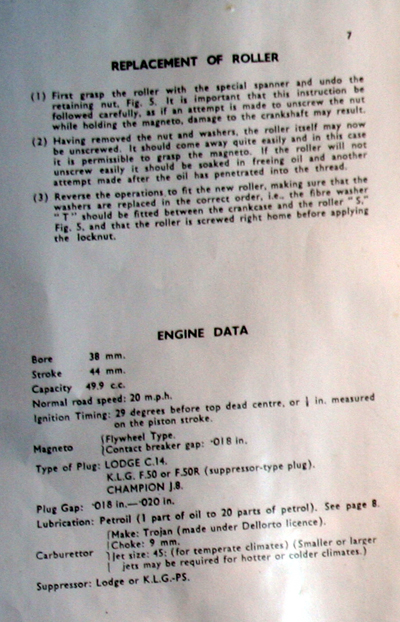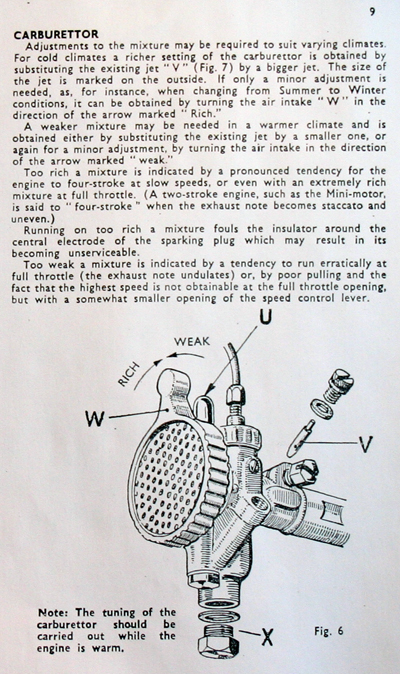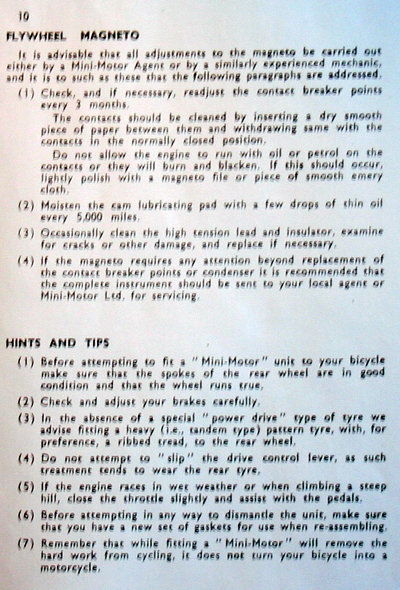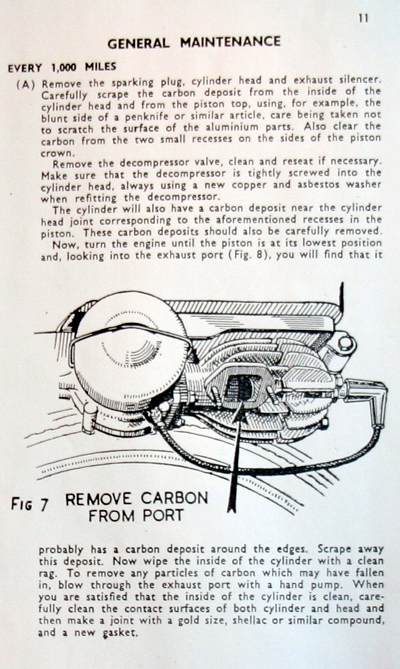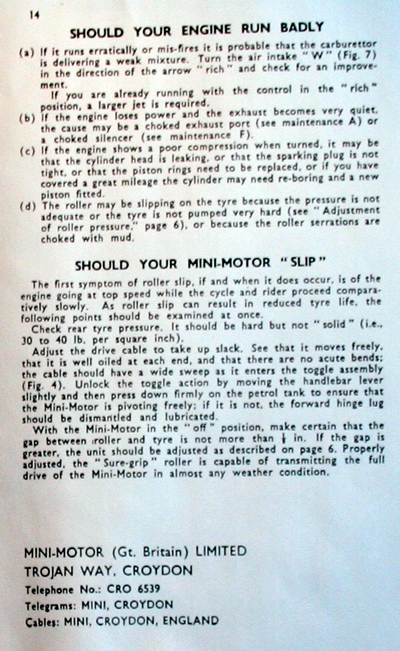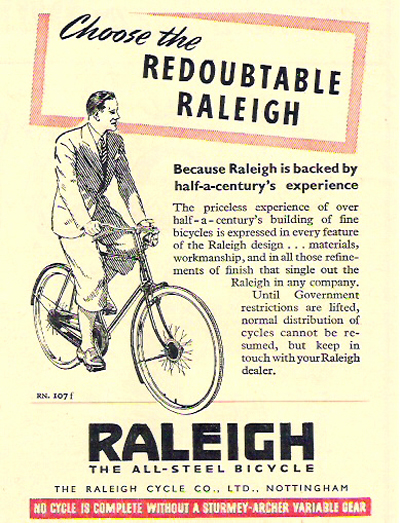PAGE 13. Trojan History: Mini-Motor; Raleigh All Steel Cycle & 1958 RM1
Trojan History & the Trojan ‘Gearless Cycle Outboard’ Mini-Motor
The Mini Motor was one of the best-known of the British clip-on engines, and was introduced in Great Britain in 1949. Though rarely referred to as such, the Instruction Book for the Mk 5 model (the last of them) describes it as a ‘Gearless Cycle Outboard.’
*******************************************************************************
Trojan Cars and Vans
Trojan’s first prototype vehicle was built in 1910, a 2-seater car with a 4 cylinder 2-stroke engine mounted between the seats. Eventually, Leyland Motors built a modified version of Trojan’s first car as the ‘Utility’ in 1922, and it sold for £175. The original prototype Trojan, hand built by Lesley Hounsfield, is pictured above; it is now owned by the Trojan Museum Trust.
In 1935 Trojan tried to move upmarket with the Mastra Limousine (above); it was not a success, and their car production finished in 1937. They continued their commercial vehicle range: you can see, below, the Trojans available in 1950 when the Minimotor was also being produced. The ‘Brooke Bond Tea’ van was Trojan’s most well-known vehicle; boys of a certain age would remember it as a Dinky Toy.
***************************************************************************
Trojan Minimotor
The Trojan Minimotor was originally designed by Vincent Piatti in 1946 as a unit to power portable lathes; he saw its advantages as a cycle-attachment and introduced it in Italy as the ‘Mini Motore.’
Five models were produced in Britain at Trojan’s Croydon factory, from the Mark I in 1949 to the Mark V in 1955. The improvement for 1951 was a decompressor added to the cylinder head to aid both starting and stopping.
The engine sat above the bicycle rear wheel, which it drove with a friction-roller on the left-hand end of the crankshaft. On the right, there was a Wipac flywheel magneto, and between this and the roller, a crankcase with bobweight flywheel and a horizontal iron barrel. An alloy head closed this, and the capacity was 49.9 cc for the conventional two stroke unit. The petrol tank went over the engine with the number plate fitted behind it. A means of lifting the roller clear of the tyre was provided .
The unit could drive a bicycle at 30 mph, which was probably as fast as you’d want to go on a normal cycle under normal road conditions. In a postwar Britain with a shortage of new vehicles, motorists found them ideal for short trips, commuting to the station or the office, or to the shops to fill up the front basket. Some were even fitted to tandems, where they proved equal to the task of hauling two people along at 20mph.
***************************************************************************
I’ve owned over a dozen of Minimotors over the past 25 years. I’ve never been particularly attached to them as they were always common, but latterly I’ve started to like them again. The bare engine pictured here is a recent acquisition, purportedly unused. Once I find a tank and fittings, I’ll put it onto a cycle.
***************************************************************************
***************************************************************************
Elswick Trojan Moped
The Trojan Moped was an experimental model, with an uprated Elswick frame similar in concept to Cyclemaster’s Norman Cyclemate. But before production could start, the ‘moped onslaught’ of 1955 killed off British cyclemotors and Trojan wisely did not put it into production.
***************************************************************************
Vincent Piatti
Vincent Piatti is also famous for his design of the Piatti Scooter, which was marketed by Cyclemaster in 1956 (See page 58). He was a brilliant designer and engineer. My friend Nick is an ardent Piatti enthusiast; in a recent email, he comments:
“Vincent passed away about 18 months ago and I am still in touch with his family. I visited him several times and even spent time with him in Sardinia where he had a vineyard on the coast and even went windsurfing in his 80s!
.. that’s when he wasn’t working of course.. yes, he was still designing combustion chambers and engines for the automotive giants until his last day.
It’s funny that he’s more famous for the design of this little scooter than some of the inventions which went into much higher production numbers, like the twin spin combustion chamber or TSCC he invented for Suzuki.”
Later…
nick
***************************************************************************
1951 Trojan Minimotor Mk 3 on Raleigh All Steel Cycle
I’ve been searching for a good Minimotor for a while now; I recently purchased this one on a Raleigh ‘All Steel’ bicycle.
Both the Minimotor engine and the bicycle have been beautifully restored.
It’s interesting to see a Minimotor in black. Of course, prior to the fifties, black was the only colour option for most vehicles – so when there was a wider choice of colours on offer not many folks wanted a black vehicle.
(Other colours available were white, black, bronze and 2 shades of blue).
…But the Raleigh All Steel is a large, handsome cycle, the kind of machine you may well have seen a village bobby riding on his rounds in the 1950s. So a colour-coordinated Minimotor certainly looks the part.
Only a few small jobs to do on this Minimotor to finish it off, and then it will be ready to show.
*******************************************************************************
Dating a Trojan Mini Motor
*******************************************************************************
1949 Newspaper Articles introducing the Minimotor
*******************************************************************************
1950 Impressions of Owning a Minimotor
The following article appeared in ‘Motor Cycling’ magazine on 27th July 1950:
*******************************************************************************
*******************************************************************************
The Mini-Motor Instruction Book
*******************************************************************************
I hope that this page has provided you with some inspiration to find yourself a Trojan ‘Gearless Cycle Outboard’ Mini-Motor. They’re simple to fit to your cycle, and to use (I hide mine inside a large rear saddlebag). They are also an ideal cyclemotor to start what I hope may soon become an obsessive cyclemotoring addiction such as that suffered by the rest of us 🙂
*******************************************************************************
xxxxxxxxxxxxxxxxxxxxxxxxxxxxxxxxxxxxxxxxxxxxxxxxxxxxxxxxxxxxxxxxxxxxxxxxxxxxxxx
*******************************************************************************
The Raleigh All-Steel Bicycle
I particularly like these Raleighs. Sheldon Brown has a good website, and provides information on dating them. Here’s what he says about this model:
For many years, in many parts of the world, the Raleigh “Sports” three-speed bicycle was considered the ultimate in human-powered transportation. These bicycles were not toys, and, despite the model name, they were not sporting equipment…they were serious vehicles. The men and women who built them, by and large, also rode them, as their primary means of transportation.
Most modern bicycles are designed with the primary intent to catch your eye on the sales floor, and persuade you to buy. That is not what a Raleigh Sports was about…these were designed to provide solid, dependable transportation for the British public, at a time when only the upper classes had motorcars. These bikes were built to last 100 years, with reasonable care.
“The All Steel Bicycle”
Contemporary bicycles have many parts made of aluminum (or “aluminium,” if you prefer) for lightness, strength and corrosion resistance. Contemporary bicycles that have steel rims, or cranks, or handlebars, or brakes do so as a way of cutting corners and saving a little bit of money, for a low-end bicycle. Modern steel rims, cranks, etc are of low quality, because they are aimed at the cheapest possible price point.
From the mid 19th century, well into the 20th, the word “steel” was magic in Britain. Britain’s rise to an industrial superpower on the crest of the Industrial Revolution was based, as much as anything else, on the steel industry and the new technologies it made possible: steel ships, steel bridges, steel buildings…and steel bicycles. Raleigh originally introduced the slogan “The All Steel Bicycle” to differentiate Raleighs from competitors who used cast iron for some critical parts, a heavier and cruder technology.
The mystique of steel caused the British cycle industry to be slow to adopt newfangled materials such as aluminum, and many British cyclists believed, even well into the 1960’s, that steel rims, for instance, were superior to aluminum ones. These days, this seems laughable…but if you look at an older Dunlop steel rim, you’ll find a very respectable, well-made product.
The fact that Raleigh 3-speeds are made of steel shouldn’t fool you into thinking that these bikes were cheap or inferior in any way…they were not…they were the finest utility bicycles money could buy.
Raleigh 3-speed bicycles were introduced around the turn of the century, and kept improving in technology over the years, reaching a peak in quality probably in the mid-to-late 1950s. They continued to be built in Nottingham until the mid-1970’s, when the glamour of the 10-speed fad pushed them out of favor with the rising baby boom generation.
http://www.sheldonbrown.com/raleigh.html
*******************************************************************************
1958 Raleigh Moped RM1
Like most cycle manufacturers, Raleigh Industries decided to have a go at making mopeds, and in 1955 they launched the Hercules Grey Wolf, renamed the Her-cu-Motor. (The company, as TI, had already purchased Hercules in 1947). You can read its full story on Page 7 of the Cyclemaster Museum. As mentioned there, its production ceased in 1958.
That same year, presumably to replace the Her-cu-Motor, Raleigh introduced a more conventional moped than the Her-cu-Motor, which was called the Raleigh ‘Moped.’
That name might seem a bit daft retrospectively, as ‘moped’ is now obviously a generic term for this style of machine. However, in the late fifties, the word ‘moped’ or ‘mo-ped’ was still new (a combination of the words ‘motor’ and ‘pedals’) and the French company Motobecane had successfully used the name ‘Mobylette’ for their machine, the word ‘mobylette’ or ‘moby’ becoming the generic term in France for mopeds. In Great Britain, the Motobecane moped was marketed as a ‘Mobylette’ and most people thought that was the name of the manufacturer.
Despite such cunning marketing strategies, the Raleigh ‘Moped’ – now known by collectors as the RM1 – was not a success in the extremely competitive new 49cc market. Though it was sturdily built, the Raleigh had no suspension, and no gearbox or clutch. The model was only made for 2 years, and in 1960 Raleigh imported and sold the French Mobylette as its replacement.
In case you were wondering why I’ve included the Raleigh RM1 in this page on the Trojan Minimotor, there is a connection, so it offers a useful footnote. As they say in the movies to announce the possibility of a sequel:
“The End ……Or is It?”
Firstly, the sturdy and well-built Raleigh All Steel bicycle featured above was a popular contemporary choice for mounting a cyclemotor engine such as a Minimotor, so a machine such as the ‘Raleigh Minimotor’ might be considered Raleigh’s first ‘unofficial’ 1950’s motorized 2-wheeler model.
But the Raleigh Moped RM1 – a British-built machine sold at a time when the 49cc market was dominated by foreign competition – had another claim to fame – because the engine of the RM1 is actually derived from the Minimotor!
“Externally it appears a quite neat and original design, but internal examination reveals that the porting and combustion chamber shape are derived from the Trojan Mini-Motor. Although the engine carried the name Sturmey-Archer and Raleigh claimed it was “designed by Sturmey-Archer Technicians” it was in fact built for Raleigh by BSA and designed by the Italian engineer Vincenti Piatti. Piatti was the designer of the Mini-Motor and he reused this design for the Sturmey-Archer engine. Mechanically, the engine is quite different from the Mini-Motor but the piston, porting and combustion chamber designs are the same.”
This is revealed in Andrew Pattle’s article on the RM1 first published in March 1997, and found here:
http://www.users.globalnet.co.uk/~pattle/nacc/arc0238.htm
Andrew’s summary of the RM1 illustrates its shortcomings:
“This, of course, meant that from the outset the RM1 was saddled with an engine which was already 10 years out of date. A Mini-Motor will push a pedal-cycle along quite adequately but the additional weight and drag of the Moped with its fat 2 inch tyre was hard work for the Sturmey-Archer engine and performance was sluggish, especially at low revs. Things were improved a little when Raleigh started to fit clutches to the RM1 (a conversion kit was available for older models). This manual clutch made the RM1 awkward to ride – much better than the almost-impossible-to-ride clutch-less version. Being a manual clutch led to an excess of levers on the handlebars. To save the rider the problem of growing an extra arm, Raleigh fitted coupled brakes. The right hand lever operated two cables, one to each brake. The left hand brake lever was now not needed but was retained, operating the rear brake, thus complying with the legal requirement to have two independent braking systems.”
